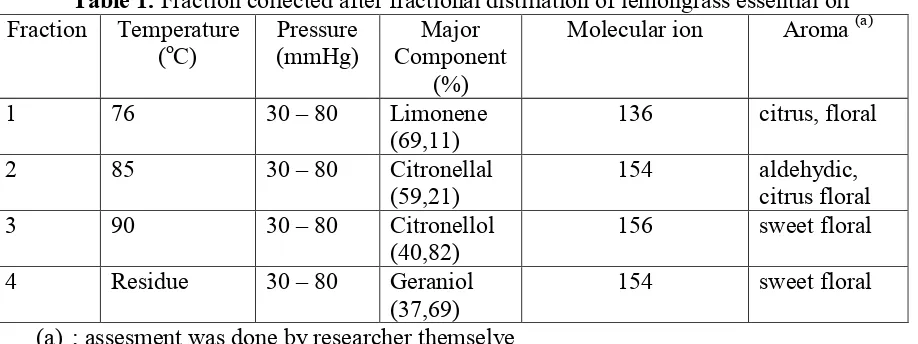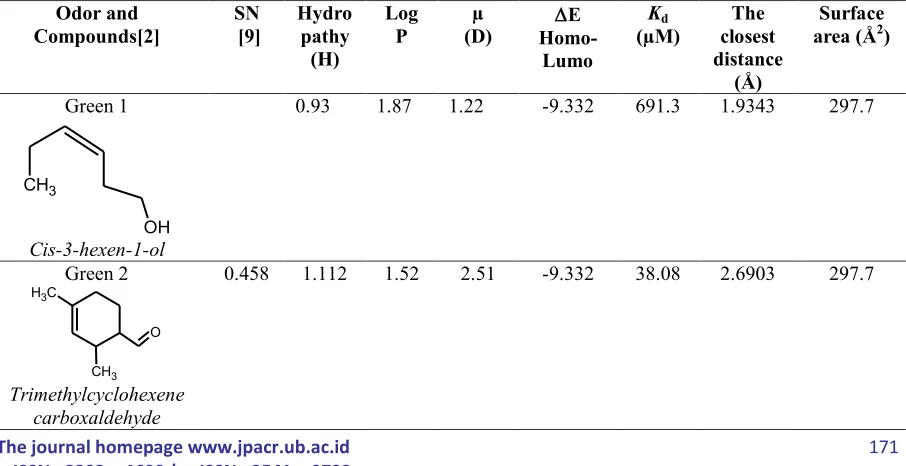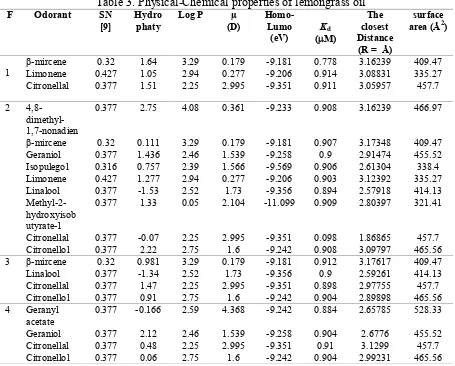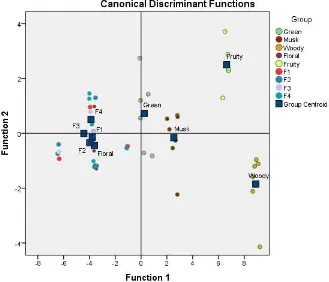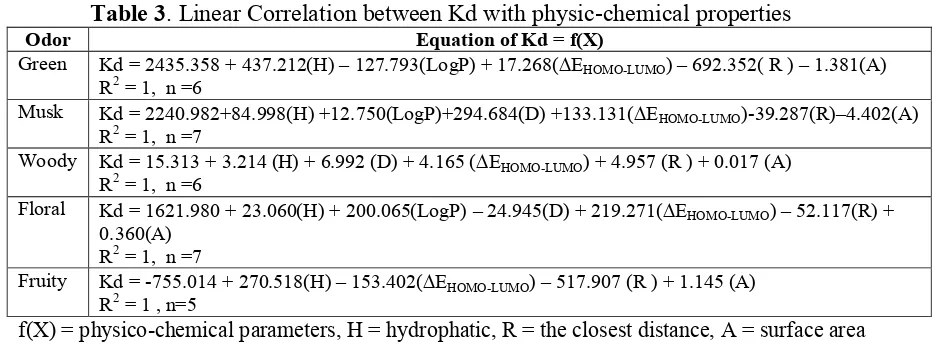The journal homepage www.jpacr.ub.ac.id p-ISSN : 2302 – 4690 | e-ISSN : 2541 – 0733
This is an open access article distributed under the terms of the Creative Commons Attribution-NonCommercial 4.0 International which permits unrestricted use, distribution, and reproduction in any medium, provided the original work is properly cited.
(http://creativecommons.org/licenses/by-nc/4.0/)
Profiling of The Lemongrass Oil Aroma and Their
Structure-Odor Relationship:
In Silico
Study
Udrika Lailatul Qodri1, Edi Priyo Utomo1,*, Elvina Dhiaul Iftitah1
1
Chemistry Department, Faculty of Science, Brawijaya University, Jl. Veteran Malang 65145 Indonesia
*
Corresponding email : [email protected]
Received 2 March 2017; Revised 6 May 2017; Accepted 9 May 2017
ABSTRACT
Structure-odor relationship (SOR) has previously studied by semantic numerically in different Fragrance. We hypothesise that in silico method such as molecular dynamics, together with docking of the interaction between human olfactory receptor (OR1G1) and ligands, can offer extremely valuable tools of modelling SOR. Hence, the present study was carried out to express the SOR of citronellal oil fraction compare with reference smelling of floral, musk, green, wood, and fruit by employing docking and multiple discriminant analysis (MDA). Our study reveals that the number dissociation constant (Kd),
bond distance, HOMO-LUMO (AE), dipole moment, kind of amino acids, Log P, surface area and hydropathy as the variable SOR from in silico anaysis. Our result has shown ligands and OR1G1 interacted with Van Der Waals and electrostatic model. MDA analysis shown molecule reference floral and fraction of lemongrass oil have similar correlation based on variable SOR with linier regression of all variable SOR to Kd value for every reference odor is R2 = 1.
Keywords : Structure odor relationship (SOR), in silico, lemongrass oil, fractional distillation, multiple discriminant analysis.
INTRODUCTION
The journal homepage www.jpacr.ub.ac.id p-ISSN : 2302 – 4690 | e-ISSN : 2541 – 0733
167
An effort with the aim to reduce panelist subjectivity, some researchers attempted to
linkage quality of scent’s source with the physico-chemical properties of each molecule. This is known as a structure-odor relationships (SOR) [2,3]. Some reports for SOR analysis relevant to that the nature of scent. But, a few of these methods still remain inconsistency result. The SOR approach through computational strategy provided a quick, acceptable and promising result [4]. Humans are able to perceive odorants through a complicated sense mechanism. The perception against to aroma evoked by an odorant is primarily triggered by the recognition of one or a mixture of molecules containing in the odorants by olfactory neurons called olfactory receptor (OR) [5]. The OR’s are the largest sub-family within Class-A G Protein-Coupled Receptors (GPCRs). GPCRs are seven trans-membrane domain (7 TM) proteins that transmit extracellular signals across the plasma membrane and one of the trans-membrane is called as olfactory receptor family 1 subfamily G member 1 (OR1G1). This OR1G1 is also synonyms to OR17-209 because an interaction between odorant molecules with amino acids residue occurred along to these regions [6]. Although some ORs can be excited for odorants, numerous ORs can be activated by very different odorants with almost similar in their molecular structure. In other words, theoretically, one OR can detect more than one odorant molecules and one odorant can be recognized by some OR [7]. For examples, OR1G1 empirically can recognize the odorant type of fruity, sweet, fat and wax, whiles OR5G1 is for fruity, sweet, fat, and strong odorant types[8].
Several methods have been developed to determine the odor which include semantic or numerical profile analysis [9]. The methods use someone experienced in a smell that was called as a panelist. Panelist determines the quality (sweet, citrus, fresh, etc.) or quantity (weak, medium, strong) of smell. But, this analysis is very subjective as everyone has different odor descriptions. So it is necessary to analyze the structure of odor molecules. Meanwhile, odor quality is influenced by the physico-chemical properties, such as molecular structures, smell of functional groups, polarity, hydrophobicity, and dissociation constant [2,3, 8, 9]. Mori et al. [10] reported some compounds typed aliphatic alcohols (OH) has a similar odor of “sweet and fresh“. Rosister [3] reported as well, a structure odor relationship and odor semantic description from many previous researchers by using QSAR analysis (quantitative structure-activity relationship) of some structures with a smell of wood, green, fruit, floral, and musk.
Computationally or in silico strategy with docking method virtualizes the interaction of odor molecules (ligands) with human proteins. This study uses OR1G1 of Homo sapiens (Human) as olfactory receptors. OR1G1 represents of several olfactory receptors, and because OR1G1 can also be activated by various types of odor molecules [4]. Thus, it will be more effective, if it is operated using a docking method in computational chemistry. In silico data is considered as a parameter of SOR, and processed by PCA (Principles Component Analysis) to determine the closeness between compounds with different fragrance [5].
The journal homepage www.jpacr.ub.ac.id p-ISSN : 2302 – 4690 | e-ISSN : 2541 – 0733
168
developed to have a high accuracy such as Autodock Tools[15], DOCK[16], iGEMDock[17]. Odorant molecules can be docked into receptor OR1G1 and virtualized a docking result in the form as single ligand docking (in AutodockTools)[15] or multi-ligand docking (in iGEMDOCK)[17].
This paper reports a modeling of molecular interaction between chemical composed lemongrass oil with Homo sapiens olfactory receptor (OR1G1) and compared to the various molecules odorant ligand with various different smell, such as green, musk, woody, fruity and floral smell as a reference. Meanwhile a structure-odor relationship (SOR) will also be reported as well based on their physicochemical properties that have been explored.
EXPERIMENT
Chemicals and instrumentation
Lemongrass oil was purchased from a rural market and treated by drying with MgSO4 anhydrous prior to further separation. A set of fractional distillation glassware was used for separation this oil into its fraction. Each collected distillates were determined their chemical composition using Gas Chromatography-Mass Spectrometer from Shimadzu QP 2010 completed with capillary column RTx-5MS (30 m) and Library from Wiley 8.
Computational docking approaches used software such as AutodockTools 4.1 for educational purpose, which installed into a Notebook from HP Pavilion with specification of processor from Intel Celeron CPU N2840 2.16 GHz 4GB 64 bit. Optimation on the molecular geometry of the ligand was performed by software from Hyperchem or any software available free in internet.
The chemicals structure of odorant was downloaded from www.chemspider.com then optimized the geometry using Hyperchem software. The types of the aroma were such as green, woody, musk, fruity and floral were explored from www.thegoodscentcompany.com. or www.sigma-aldrich.com. The odorant receptor of OR1G1 was downloaded from http://www.uniprot.org/uniprot/P47890 in the form of amino acid sequence. The three dimensional structure of OR1G1 receptor was constructed by sending this sequence to www.swissmodel.expasy.org to build a quarternary structure prior to docking.
Fractional Distilation of Lemongrass Oil
Lemongrass oil of 100 ml was separated into fractions by fractional distillation with reduced pressure. Each fraction was collected at certain temperatures and pressure. For determination of the components in each fraction distillate, 2 L of distillate was injected into Shimadzu QP 2010 GC-MS machine with operational condition as follows : carrier gas helium at 0.66 mL/min, column Restek Rtx-5MS, injection temperature at 310 °C, split ratio : 139, programmed temperature from 50o – 310oC with increasing temperature at 10o/minute, Ion source temperature : 200oC, interface temperature : 300oC, scanned at m/z : 40 – 600 at scan speed : 1250 amu/sec.
Preparation Macromolecule OR1G1 and Odorant Ligand for Docking Computation
The journal homepage www.jpacr.ub.ac.id p-ISSN : 2302 – 4690 | e-ISSN : 2541 – 0733
169
docking. Three dimensional structures of the ligands were downloaded from www.chemspider.com and then its geometry of the molecular structure was optimized using HyperChem software. Semi-empirical AM1 was used to compute this internal energy until obtain a lowest energy, then followed by QSAR computation to get physico-chemical properties parameter such as log P, moment dipole (D), EHOMO-LUMO, and surface area (A)
of the ligand. The file of virtual structure of both receptor and ligand were then converted into file.pdb format using Open Babel GUI software.
Processing of Docking
For the reason of multicomponent (multiligand) containing in the distillate fraction of lemongrass oil, the multiligand were docked into receptor OR1G1 using IGEMdock software for modeling the interaction between receptor OR1G1 with ligands of each fraction distillate. The computational calculation were done with including parameters for multiligan docking system including Docking Accuracy Setting (Generic Algorithm : GA) : population size: 200; generation: 70, number of solution: 2, default setting: standard docking.
Whiles the virtual molecular structure of each green, fruity, woody, musk and floral as reference ligands odorant were also downloaded from www.chemspider.com, then they were docked into receptor OR1G1 using AutodockTools 4.1. The next is running a grid made with three kinds of grid box positions, the first position dimension x = 126; y = 114; and z = 62, the second position with dimensions x = 126; y = 100; z = 46, and a spacing of 0.375 angstroms. Furthermore docking was performed using a Genetic Algorithm computation. After processing of docking finished, the model of interaction was visualized by using Discovery Studio Visualizer 3.5 software.
Both processing of the docking for ligand of the reference odorant and component of each fraction distillate were analyzed their interaction in the form of the receptor-ligand complex based on their Kd (dissociation constant) which basically analog with Ki (inhibition constant).
Treatment of the parameter docking with Linier Discriminant Analysis (LDA)
All data from in silico were tabulated into dependent variables. SPSS and excel software were used for treating data to obtain an appropriate modeling receptor-ligand interaction and also Structure and Odor Relationship (SOR). Mapping of the R-L interaction was also explored using Discovery Studio Visualizer 3.5 software to get the region of amino acid residue region that specifically interact to the ligand with hydrogen bonding, van der Waals, hydropathy (H), a closet distance of atomic-atomic interaction (R).
Modeling receptor-ligand interaction explored with MDA will result a map in which represent a similarity and dissimilarity of the ligand component containing in each distillate of lemongrass oil compared to the reference ligands of green, fruity, woody, musk and floral odorant.
RESULT AND DISCUSSION
Physicochemical Character of Fraction distillate
The journal homepage www.jpacr.ub.ac.id p-ISSN : 2302 – 4690 | e-ISSN : 2541 – 0733
170
aroma tends to terpenic character. It is very relevant to organoleptic that listed in www.thegoodscentcompany.com or other odorant database.
Table 1. Fraction collected after fractional distillation of lemongrass essential oil Fraction Temperature
(oC)
Pressure (mmHg)
Major Component
(%)
Molecular ion Aroma (a)
1 76 30 – 80 Limonene (69,11)
136 citrus, floral
2 85 30 – 80 Citronellal (59,21)
154 aldehydic, citrus floral 3 90 30 – 80 Citronellol
(40,82)
156 sweet floral
4 Residue 30 – 80 Geraniol (37,69)
154 sweet floral
(a) ; assesment was done by researcher themselve
Modelling of Interaction odorant Ligand with receptor OR1G1
In silico, Interaction between ligand and protein of OR1G1 produced 10 models conformation. The smallest value of inhibition constants (Ki = Kd) is expressed as the best
conformation, where this conformation of the complex receptor-ligand (R-L) is the most stable (table 2). The modeling of the interaction between ligand and OR1G1 shows van der Waals and electrostatic bonding interaction (Figure 1). The van der Waals interaction was occurred in nonpolar compounds, meanwhile electrostatic occurred in polar compounds (Figure 1A). In addition, the blue color attached to the sphere of amino acids and odor molecules indicate hydrogen bonds (Figure 1A). A growing number of hydrogen bonds influence the intensity of the odor in the human sense of smell. Moncrieff [13] reported that the presence of hydrogen bonding, the smell will be stronger when they are close to each other. In addition, based on compound of citronella oil (Tabel 2), citronellal compound has a group C=O, sitronelol has a C-OH and geraniol has a C-OH equally has a floral odor. This is accordance with article Rossiter [3] which compounds with ketone group and some alcohol group as a floral odor.
The journal homepage www.jpacr.ub.ac.id p-ISSN : 2302 – 4690 | e-ISSN : 2541 – 0733
171 Figure 1. Modelling of Molecular Interaction between ligands of odor reference with OR1G1 in two dimension (A) and three dimension (B) by AutodockTool
Ligand as odorant reference with various molecular structures was accessed randomly from any odorant database such as www.thegoodscentcompany.com and handbook of flavor-fragrance from www.sigma-aldrich.com and also from Rossiter [2]. There are 6 odorant with green character and they are already determined for their empirical semantic-numeric (SN) profile conducted by Zarzo and Stanton [9]. The six musk odorants with various molecular structure have among to macrocyclic, and only one odorant have a 6-membered cyclic. The forth parameter of odorant, namely logP, moment dipole, surface area and EHOMO-LUMO were
resulted from QSAR method, whiles Kd and the closet distance of atomic-atomic interaction (R) were resulted from docking computation (Table 2). They are regarded as independent variebles in modeling of interaction odorant ligand with receptor OR1G1 to perform similarity and dissimilarity of each fractional distillate compared to the reference odorant.
Table 2. Physical-Chemical properties of molecule standart and numerically perseption by Zarzo and Stanton [9]
Odor and Compounds[2]
SN [9]
Hydro pathy (H)
Log P
µ (D)
E
Homo-Lumo
Kd
(µM)
The closest distance
(Å)
Surface area (Å2)
Green 1
CH3
OH
Cis-3-hexen-1-ol
0.93 1.87 1.22 -9.332 691.3 1.9343 297.7
Green 2
O
CH3
C H3
Trimethylcyclohexene carboxaldehyde
The journal homepage www.jpacr.ub.ac.id p-ISSN : 2302 – 4690 | e-ISSN : 2541 – 0733
172
Green 3
CH3
CH2
Undecatriene
0.458 1.71 4.13 0.428 -9.545 25.01 3.0031 481.68
Green 4
O
Phenyl acetaldehyde
0.458 1.44 0.5 2.684 -9.683 215.41 3.0981 279.54
Green 5
O
C H3
2-(4-Methylphenyl)propanal
0.458 0.929 1.22 2.75 -9.314 32.88 2.9127 342.72
Green 6
Biphenyl
0.458 1.22 1.05 2.999 -9.314 9.44 3.0769 286.55
Musk 1
CH C H3
CH2 CH2
CH2
(H2C)10
Muscone
0.495 0.162 5.43 2.928 -10.327 1.86 3.1506 435.98
Musk 2
(CH2)7
(CH2)7 O
Civetone
0.495 1.39 5.63 2.435 -9.473 1.89 2.9962 418.59
Musk 3
(H2C)12 O
Cyclopentadecanone
0.4s95 1.33 5.09 2.964 -10.352 6.75 2.8540 409.22
Musk 4
(CH2)5
O (H2C)7
O
Ambrettolide
0.495 1.128 4.5 1.624 -9.236 1.08 3.0653 374.13
The journal homepage www.jpacr.ub.ac.id
Profile the Aroma of Lemongrass oil- Fractional Distillate
The journal homepage www.jpacr.ub.ac.id p-ISSN : 2302 – 4690 | e-ISSN : 2541 – 0733
176
Table 3. Physical-Chemical properties of lemongrass oil
Figure 2. Modelling ofMolecularInteraction between ligands of lemongrass oil fractional distillate with OR1G1 in two dimension (A) and three dimension (B) by iGemdock
F Odorant SN [9]
Hydro phaty
Log P µ (D)
Homo-Lumo (eV)
Kd
(M)
The closest Distance (R = Å)
surface area (Å2)
1
β-mircene 0.32 1.64 3.29 0.179 -9.181 0.778 3.16239 409.47 Limonene 0.427 1.05 2.94 0.277 -9.206 0.914 3.08831 335.27 Citronellal 0.377 1.51 2.25 2.995 -9.351 0.911 3.05957 457.7
2 4,8- dimethyl-1,7-nonadien
0.377 2.75 4.08 0.361 -9.233 0.908 3.16239 466.97
β-mircene 0.32 0.111 3.29 0.179 -9.181 0.907 3.17348 409.47 Geraniol 0.377 1.436 2.46 1.539 -9.258 0.9 2.91474 455.52 Isopulegol 0.316 0.757 2.39 1.566 -9.569 0.906 2.61304 338.4 Limonene 0.427 1.277 2.94 0.277 -9.206 0.903 3.12392 335.27 Linalool 0.377 -1.53 2.52 1.73 -9.356 0.894 2.57918 414.13
Methyl-2-hydroxyisob utyrate-1
0.377 1.33 0.05 2.104 -11.099 0.909 2.80397 321.41
Citronellal 0.377 -0.07 2.25 2.995 -9.351 0.098 1.86865 457.7 Citronellol 0.377 2.22 2.75 1.6 -9.242 0.908 3.09797 465.56 3 β-mircene 0.32 0.981 3.29 0.179 -9.181 0.912 3.17617 409.47 Linalool 0.377 -1.34 2.52 1.73 -9.356 0.9 2.59261 414.13 Citronellal 0.377 1.47 2.25 2.995 -9.351 0.898 2.97755 457.7 Citronellol 0.377 0.91 2.75 1.6 -9.242 0.904 2.89898 465.56 4 Geranyl
acetate
0.377 -0.166 2.59 4.368 -9.242 0.884 2.65785 528.33
The journal homepage www.jpacr.ub.ac.id p-ISSN : 2302 – 4690 | e-ISSN : 2541 – 0733
177
In silico variables of reference molecule and the components of fractional distillate were processed statistically by multiple discriminant analysis (MDA). The results of MDA have seven discriminant functions, where the function 1 and function 2 (figure 3) are the largest correlation between any discriminant analysis. The canonical corelation show 0.982 for function 1 (or R2= 0.964). It means the variable influences to the function 1 are 96.4 %, function 2 is 57.9%, respectively. There are nine groups from each fucntion (figure 3). If we see from function 1 and function 2, the groups of floral, musk, fruit, wood, and green are staying far from each other. That mean, the molecule with same odor have distant correlation from molecule with dissimilar odor based on variable SOR from insilico analysis. But it have similar correlation between molecule with same odor. In another group that are fruction 1,2,3,4 and also molecule reference floral are staying nearby from each other (figure 3). That mean the variable SOR from insilico analysis give the similar correlation among the fructions groups and molecule reference floral. Based on odor perception of each component, both assessed by our researcher and also comparing to database from www.thegoodscentcompany.com, the odors profile of limonene are citrus, orange, fresh, sweet. While citronellal have odor profile of sweet, dry, floral, herbal, waxy, aldehydic and the primarily is floral, citronellol have odor profile are floral, leather, waxy, rose, bud, and citrus with the strongest odor is floral, geraniol have odor sweet, floral, fruity, rose, waxy , and citrus with the strongest odor is floral. so from MDA (multiple discriminant analysis) analysis show the component with same odor have similar correlation based on variable SOR that is momen dipole, Log P, Homo-Lumo, Kd, bond distance, hydropathy and surface area of
ligand.
The journal homepage www.jpacr.ub.ac.id p-ISSN : 2302 – 4690 | e-ISSN : 2541 – 0733
178
An odorant can be mapped to a unique location in this space according to its values for each descriptor (Figure 3). The physicochemical relationship between two odorants can then be quantitated as the Euclidean distance between them in this space. This physical odor space is useful in predicting odor perception. Linear discriminant analysis reveals a correlation between odorant and molecular structure, as defined in the space, and its perceived the type of aroma among humans both the known and unknown aroma sources.
SOR of the odorant Ligand
The regression analysis was performed by the use of a range of physic-chemical descriptors. The combination of parameters which best accounted for the observed differences in the all reference odorant (Table 3). Not all variable contribute to interaction modeling in regarding to Kd, for example, regression analysis for fruity, the most variable contribute to the equation are only hydropathy (H), EHOMO-LUMO, the closest distance of
atomic interaction (R ) and surface area (A). Only Musk and Floral show linear regression with all of independent variables. That means, the reference odorant, especially for musk and floral should be regarded to at least 6 variables which contribute to this odor type. Distribution constant (LogP) represented the odorant in mucosa was not look like important thing in the woody and fruity odorant. However, the parameter of the distance (R) and
EHOMO-LUMO contribute significantly to the interaction of the odorant-receptor complex.
Theoretically, lower gap energy of EHOMO-LUMO leads to greater the affinity of odorant
molecule against to receptor. The distance between atoms interaction become closer leads to the greater the affinity and more pleasantness in perception. It is relevant to the Rossiter statement for all kind of odor [2].
Table 3. Linear Correlation between Kd with physic-chemical properties
Odor Equation of Kd = f(X)
Green Kd = 2435.358 + 437.212(H) – 127.793(LogP) + 17.268(EHOMO-LUMO) – 692.352( R ) – 1.381(A)
R2 = 1, n =6
Musk Kd = 2240.982+84.998(H) +12.750(LogP)+294.684(D) +133.131(EHOMO-LUMO)-39.287(R)–4.402(A)
R2 = 1, n =7
Woody Kd = 15.313 + 3.214 (H) + 6.992 (D) + 4.165 (EHOMO-LUMO) + 4.957 (R ) + 0.017 (A)
R2 = 1, n =6
Floral Kd = 1621.980 + 23.060(H) + 200.065(LogP) – 24.945(D) + 219.271(EHOMO-LUMO) – 52.117(R) +
0.360(A) R2 = 1, n =7
Fruity Kd = -755.014 + 270.518(H) – 153.402(EHOMO-LUMO) – 517.907 (R ) + 1.145 (A)
R2 = 1 , n=5
f(X) = physico-chemical parameters, H = hydrophatic, R = the closest distance, A = surface area
The journal homepage www.jpacr.ub.ac.id p-ISSN : 2302 – 4690 | e-ISSN : 2541 – 0733
179
According to Rossiter [2], the green note is probably difficult to define. Term green denotes an odor which is reminiscent of green foliage such as leaves, stalks, and green vegetables, and the smell of freshly cut grass. The compound smell green such as cis-3-hexene-1-ol is commonly perceived by panelist. However, in this research, trimethylcyclohexene carboxaldehyde and biphenyl, the two compounds with different carbon skeleton and functional group were used as reference odorant, but they have the same note green. It means that SOR is still unclear. However mapping of their active binding site on the amino acid residue of OR1G1 shown a conserved region consistently in which the binding site are almost in the same region (the map note shown here). It is like to flavor site on the human tongue that has been known well [12]
CONCLUSION
Interaction between odor molecules with OR1G1 indicated by an electrostatic bonding and Van der Waals, as well as the interaction between the odors molecules with amino acids which is show from the two-dimensional structure of the complex RL (Receptor-Ligand). Citronellal, citronellol, geraniol and molecules standar floral have similar odor that interact with fenilalanin and sistein. Structure odor relationship based on the value of log P, momendipole, hydropathy, HOMO-LUMO, Kd, surface area and the bond distance with MDA analysis have similar correlation among fraction 1,2,3,4 and molecul reference floral that have same odor profile.
ACKNOWLEDGMENT
We thank to Institut Atsiri of Brawijaya University, PUI of Essential oil Agroindustry of KEMENRISTEK-DIKTI Republic of Indonesia, the head of the Chemistry Department Study Program in Brawijaya University and Mr. Widji for GCMS measurement.
REFERENCES
[1] K. Sucker, R. Both, M. Bischo, R. Guski, U. Krämer, and G. Winneke, Int Arch Occup Environ Health., 2008, 81(6), 683–694.
[2] K. J. Rossiter, E. Fruit, and H. Wood, Chem. Rev., 1996, 96 (8), 3201–3240.
[3] L. Turin, Structure-odor relations : a modern perspective in Handbook of olfaction and gustation, 1991, Wiley-Blackwell, 1–35.
[4] K. Harini and R. Sowdhamini, PLoS One, 2015, 1–30. [5] L. Buck and R. Axel, Cell, 1991, 65, 175–187.
[6] P. Mombaerts, Science, 1999, 286(5440), 707-711.
[7] B. Malnic, J. Hirono, T. Sato, L. B. Buck, and H. Hughes, Cell, 2000, 96, 713–723. [8] K. Audouze, A. Tromelin, A. M. L. Bon, C. Belloir, R. K.Petersen, K. Kristiansen, S.
Brunak, O. Tabourea, PLoS One, 2014, 9(4), 1-12.
[9] M. Zarzo and D. T. Stanton, Chem. Senses., 2006, 31(8), 713–724.
[10] K. Mori, Y. K. Takahashi, K. E. I. M. Igarashi, and M. Yamaguchi, Physiol Rev, 2006,
86(2),409–433.
[11] G. Launay, F. Wade, and E. Pajot-augy, Protein Eng Des Sel, 2012, 25(8), 377–386. [12] F. Chen and O. Martín-belloso, HANDBOOK OF FRUIT AND VEGETABLE
FLAVORS Edited by Y.H. Fuyi, 2010,John Wiley & Sons, Inc.
The journal homepage www.jpacr.ub.ac.id p-ISSN : 2302 – 4690 | e-ISSN : 2541 – 0733
180
[14] Kyte, Jack dan Doolittle, R. F., J. Mol. Biol., 1982, 157, 105-132.
[15] Morris, G. M., R. Huey, W. Lindstrom, M. F. Sanner, R. K. Belew, D S. Goodsell, A. J. Olson, J. Comput. Chem., 30(16), 2785-2791.
[16] Brozell, S. R., S. Mukherjee, T. E. Balius, D. R. Roe, D. A. Case, R. C. Rizzo, J Comput Aided Mol Des, 2012, 26, 749-773.
